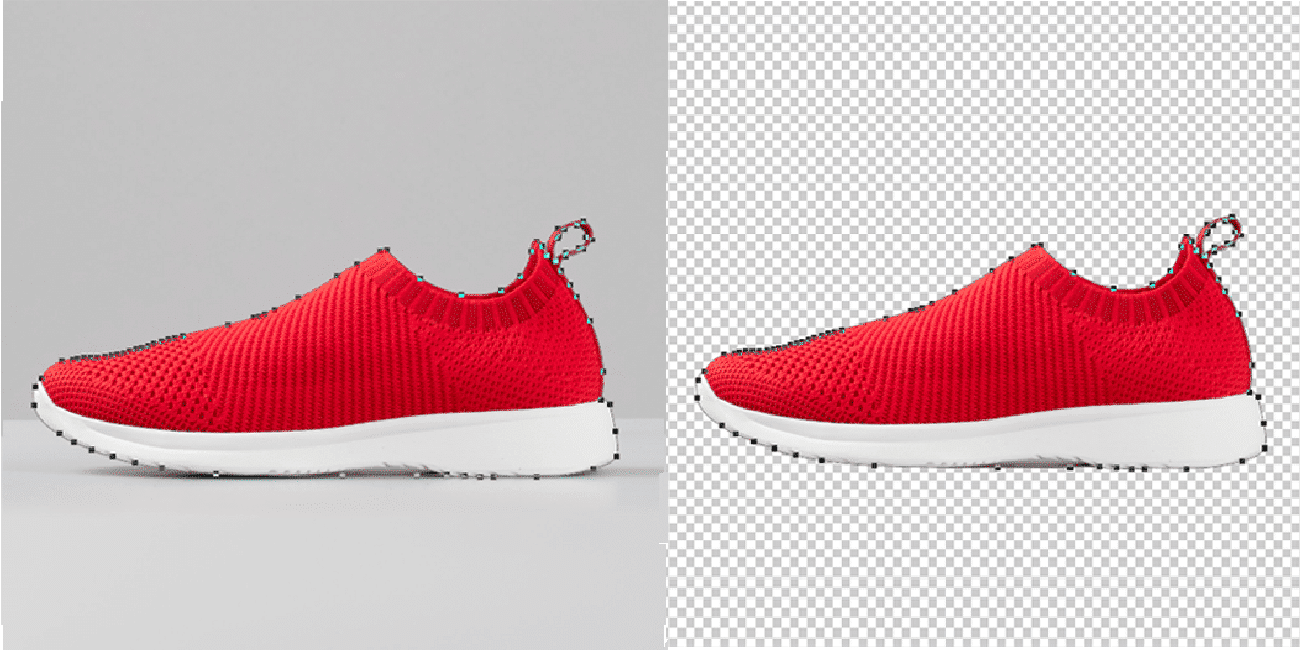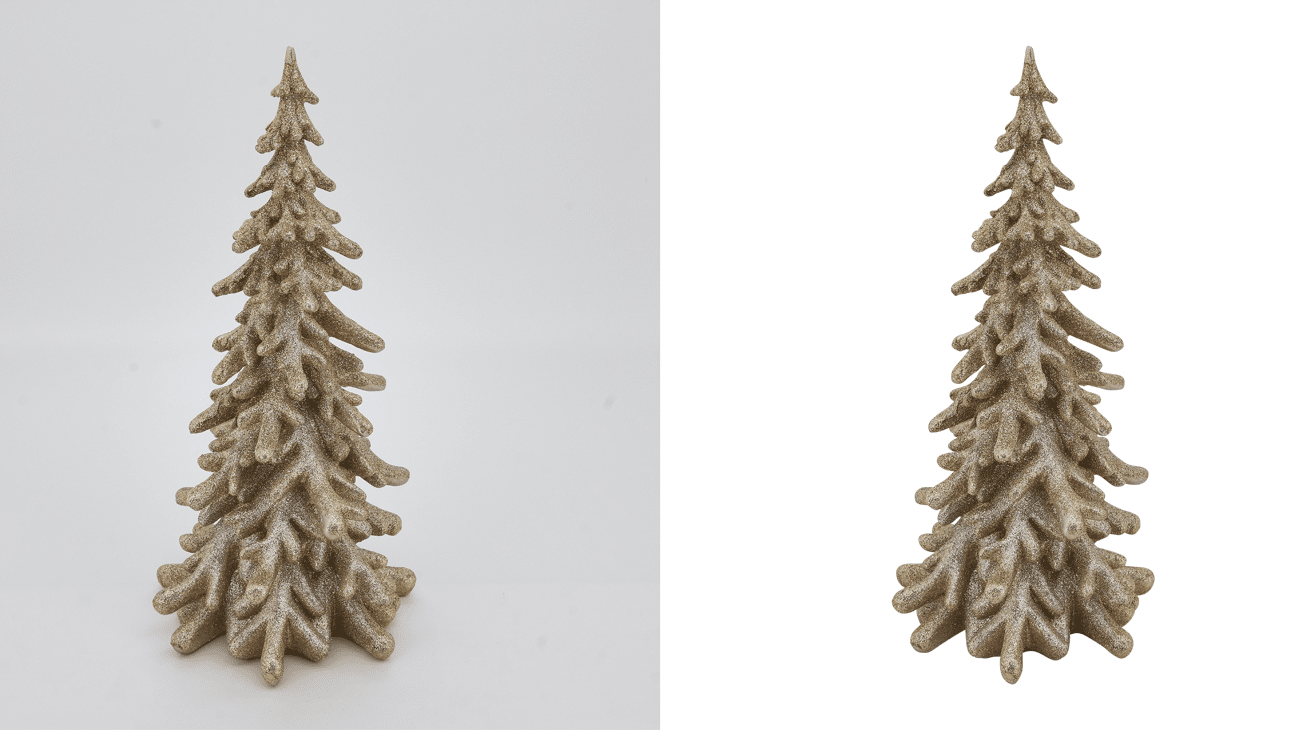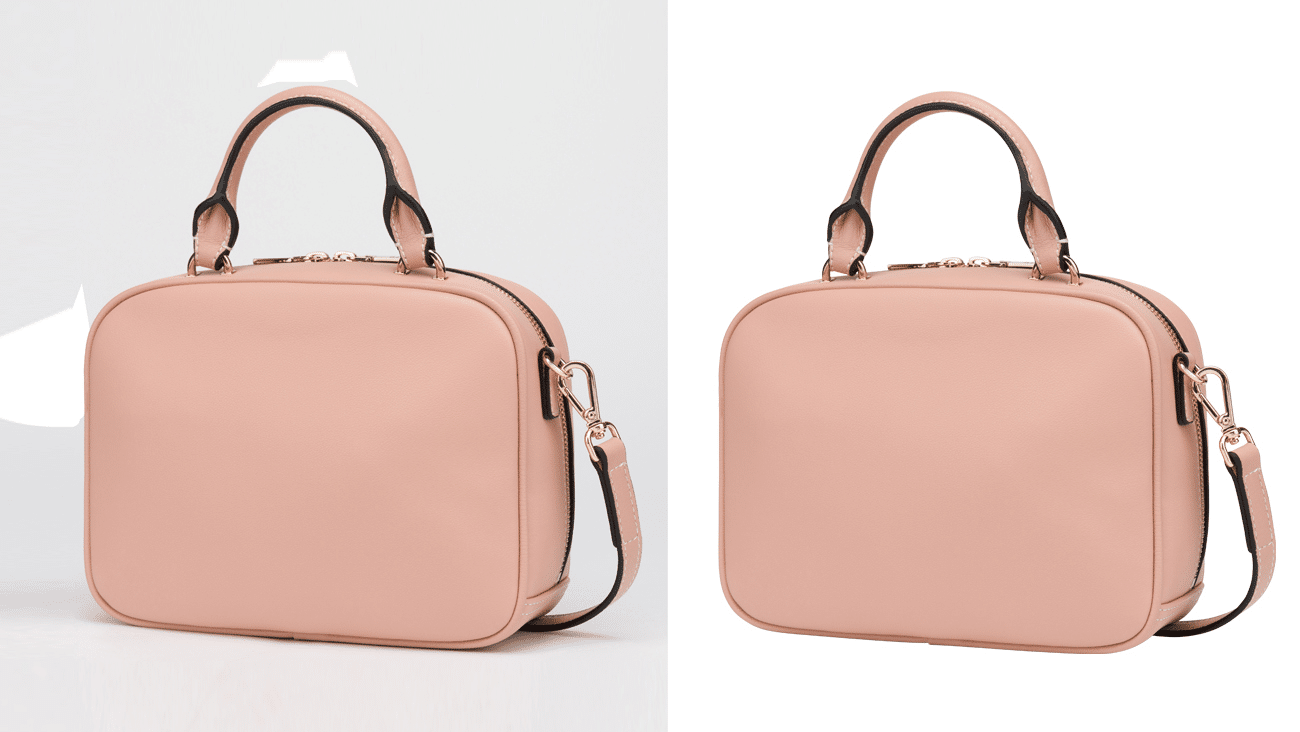Imagine being able to easily take any object from a photo and move it anywhere. This is the magic of a clipping path. They are powerful yet hidden tools that shape our visual world. Clipping paths act as invisible borders. Designers and artists use them to move objects, change stories, enhance beauty, and convey messages.
In this article, we talk all about clipping paths, types of clipping paths, use of clipping paths technique, etc.
Table Of Contents
What Is a Clipping Path?
A clipping path is a vector path that defines an object’s shape in an image. It acts as a digital boundary, separating the subject from the background. This path is usually made with image editing software, like Adobe Photoshop or Illustrator.
For example, designers use clipping paths to remove distracting backgrounds from product images. This makes the product stand out against a clean white or transparent or other background. Such a simple edit has changed e-commerce. Now, online shoppers focus only on the product.
Types of Clipping Paths
Clipping path has many types based on image quality or clipping path process. Let’s explore it:
Basic Clipping Path
A basic clipping path is a selection method. It uses the Adobe Photoshop pen tool for simple, shaped images, like round or rectangular ones. An expert image editor can precisely remove the image’s background. They can replace it with white or another color.
So, If you’re a new entrepreneur, photographer, or a photo fan, learning basic clipping paths can be a game changer. It’s vital when uploading products to your online store or refining your portfolio.
Simple Clipping Path
simple clipping path needs more effort than a basic clipping path. It’s applied in product image editing for chairs, tables, shoes, watches, etc.Editors use the Adobe Photoshop pen tool to make simple clipping paths. Using the pen tool, you can create a path around or inside the image to select the object. Then, you can make changes to the image as required. You also need professional skills to make a simple clipping path.
Characteristics of Simple Clipping Paths:
The object has clear edges and no complex details like hair, fur, or intricate patterns. The background is a solid color or a simple gradient. This makes it easier to see the subject. The object’s outline can be represented primarily by straight lines and gentle curves.
Compound Clipping Path
A compound clipping path is a vector graphic technique. It’s a popular technique in recent years. This method offers unmatched control. It is the best for isolating and manipulating images.
It involves creating multiple clipping paths and combining them to achieve intricate selections. This technique is particularly useful for:
Complex Objects: Use compound clipping paths to isolate images with multiple elements, such as products with packaging. It’s efficient.
Transparent Backgrounds: E-commerce often requires high-quality product images with transparent backgrounds. Compound clipping paths excel at this.
Image Masking: Compound clipping paths let you mask specific areas of an image, like hair or fur.
Also, image editing software is now better. It’s easier for users of all skills to create compound clipping paths. Tools and features that streamline the process have made this technique popular.
Complex Clipping Path
We use complex clipping paths for intricate images. These include hair, fur, and transparent objects. A skilled designer must define an object’s shape down to the pixel. It must be perfectly separate from its background. Compound Clipping Paths are simple. Complex ones require great attention to detail. Hair, fur, and transparent objects pose unique challenges. Their colors, textures, and opacities vary subtly.
The uses of the complex clipping path:
E-commerce Product Photography: Online retailers want to show their products at their best. Complex clipping paths are essential for isolating detailed products. include lace clothes and intricate jewelry.
Fashion and Beauty Industry: High-end brands use complex clipping paths. They create stunning product images and ads. For example, isolating a model’s hair from the background requires precision and expertise.
Real Estate Photography: Designers and agents use complex clipping paths to create stunning property listings. Designers can boost the appeal by isolating elements like furniture or architectural details.
Super Complex Clipping Path
Super Complex clipping path is a mix of simple or compound factors. The image has several objects. Or they have critical shape. Yet, you need high-level skills to edit the super complex clipping paths. Super complex ones involve intricate images, like vehicles, fur, transparent objects, etc.
Creating super complex clipping paths is a time-consuming and challenging process. It requires a deep understanding of image editing software, like Adobe Photoshop. It also needs a keen eye for detail. Some common challenges include:
Hair and Fur: Outlining individual strands of hair or fur requires precision.
Transparency: Clipping paths for transparent objects, like glass or water, require special techniques.
Shadows: Complex shadows can be hard to separate from the main object. Doing so may lower image quality.
To solve these problems, image editing experts use manual methods and automated tools. Advanced software and plugins can help. But, human expertise is still vital for the best results.
Multi-Clipping Path:
The complex part of image editing is making precise cutouts or clipping paths. Traditional clipping paths isolate a single subject. But, multi-clipping path is isolating multiple object of an image. It offers unmatched flexibility in design and composition.
The multi-clipping path is a meticulous process. It requires skilled editors to outline each subject’s edges in an image. This intricate task is essential for various applications, including:
- E-commerce product photography
- Graphic design
- Removing unwanted elements
Get the best result for the Multi-Clipping Path
To achieve optimal results, consider the following best practices:
- High-resolution images: Start with high-quality images to ensure precise clipping paths.
- Clear subject boundaries: Images with well-defined subject boundaries simplify the process.
- Use the same color and lighting in the image for accurate selections.
- For complex images or critical projects, hire a pro clipping path service.
Clipping Path Illustrator :
Clipping Path Illustrator is a powerful tool. It offers unmatched control over image editing. It guides the creation of one or more vector shapes of the image object. It’s one of the nondestructive paths of any design. You can resize the images without affecting the resolution.
Key Benefits:
- Precision: Create highly accurate selections with intricate details.
- Flexibility: Modify clipping paths easily to adapt to design changes.
- Efficiency: Streamline image editing and manipulation processes.
- Scalability: Maintain image quality regardless of size adjustments.
How to Make a Clipping Path
clipping path is an essential tool for isolating objects from their background. This technique is common in e-commerce, design, and photography. It creates clean, professional images. Creating a clipping path is now easier with better software and techniques. Let’s dive into the modern approach to this crucial skill.
Tools and Software
Several softwares are available to create clipping paths. The most popular choices include:
- Adobe Photoshop: The top tool for image editing. It has strong tools for making manual clipping paths.
- Adobe Illustrator: It is mainly a vector-based program. It excels at creating and editing complex clipping paths.
- Specialized Clipping Path Software: Some software is made just to create clipping paths. They often have features tailored to this task.
Steps to Create a Clipping Path
While the exact steps may vary based on the software used, the general process involves:
- Image Preparation: The image must be high-contrast for a special clipping path.
- Pen Tool Precision: Use the pen tool to carefully trace the outline of the object. Pay close attention to details like hair, fur, and intricate edges.
- Path Refinement: Adjust the path points and handles to create a smooth and accurate shape.
- Path Conversion: Convert the path into a clipping path or selection.
- Quality Check: Simply inspect the clipping path for any errors or imperfections.
Tips for Efficient Clipping Path Creation
- Image Quality: For accurate clipping, use a high-quality image with good contrast.
- Master the Pen Tool: Practice using the pen tool to achieve precise and smooth paths.
- Use Layers: Create layers for different parts of the object. This will simplify the process.
- Utilize Shortcuts: Learn keyboard shortcuts to speed up your workflow.
- Consider Outsourcing: For large volumes of images, consider outsourcing the task to professionals.
Why Is Clipping Path Important?
The quality of an image can make or break a product, a brand, or even a social media post. Many focus on filters, lighting, and composition. But, a crucial process is often overlooked: clipping path.
Here’s why the clipping path is essential:
1. Background Removal Magic
The most apparent use of clipping path is removing backgrounds. For e-commerce, you may want a product on a white backdrop. For ads, you may want it in a complex scene. A clean clipping path is the foundation for both.
E-commerce: Consistent product backgrounds enhance professionalism and improve customer experience.
Graphic Design: Clipping paths allow seamless integration of images into layouts.
2. Image Masking Mastery
Clipping paths do more than remove backgrounds. They also mask images. This technique isolates parts of an image. Then, it allows for color correction, shadowing, or adding effects.
Photography: Masking can be used to retouch portraits or enhance product images.
Design: Complex compositions often require precise masking of elements.
3. Image Composition and Manipulation
Clipping paths give you full control over image composition. You can mix elements, create collages, or alter an image’s perspective.
Advertising: Create dynamic and eye-catching ad compositions.
Art and Design: Experiment with different image arrangements.
4. The Ecommerce Advantage
In online shopping, product images are crucial. Clipping paths make these images professional and eye-catching.
Product Catalogs: Consistent and clean images improve product presentation.
Customer Confidence: High-quality images build trust and promote purchases.
What Is the Purpose of Clipping Path?
The main purpose of the clipping path is to isolate an object from its background. This allows for manipulation and placement on different backgrounds. This isolation grants creators unparalleled flexibility in crafting visual content.
Key Applications of Clipping Path:
- Graphic Design: Clipping is fundamental to creating logos, icons, and illustrations. Designers can extract elements from images and combine them to form new compositions.
- Photography: Product photography often uses clipping to isolate products for web or catalog displays.. This technique enhances the product’s visual appeal by removing distracting backgrounds.
- Video Editing: Clipping is essential for video editing. Editors can extract scenes, transitions, or effects from footage. They can then use them to create engaging narratives.
- E-commerce: Product images with clean, white backgrounds are often created using clipping. This presentation style highlights the product and improves its online visibility.
Technology has made clipping easier and faster. Editors like Adobe Photoshop and GIMP offer precise clipping tools. Moreover, online services now provide automated solutions for bulk image processing.
Benefits of Clipping Path
Clean and Professional Image Presentation
A well-clipped image looks professional. Removing unwanted backgrounds makes the subject stand out. This is important for e-commerce products. Customers often decide to buy based on images.
Versatility in Image Usage
clipping path offers various options for editing images. It allows you to change backgrounds, add effects, or merge images seamlessly. This flexibility is vital for creating ads, social media graphics, and marketing materials.
Enhanced Product Visualization
Clipping paths allow displaying products from various angles, backgrounds, or lighting. This helps customers imagine the product in their space, boosting purchase chances.
Time-Saving in Image Editing
Manually removing backgrounds can be time-consuming and tedious. The clipping path offers a more efficient solution. Once you make the path, you can reuse it for different image formats and sizes. This will save you time and effort.
The rise of e-commerce and social media has made quality images important. Businesses and people now invest more in them. Clipping paths are key in this process. They enable businesses to showcase user-generated content by removing backgrounds from products. This maintains a consistent brand image.
Uses of a Clipping Path
clipping path, a digital tool that become indispensable for designers, photographers, and marketers. It may sound technical. But it has a big impact. It shapes how we view and engage with visual content.
The rising demand for great, eye-catching content has made clipping paths popular. Let’s explore its key applications:
E-commerce: The Product Showcase
- Product Isolation: E-commerce platforms can boost product appeal by removing backgrounds. This shows products in a clean and consistent way.
- Easy edit: Clipping paths allow easy edits You can change colors, adjust shadows, and more. This helps match different product versions or marketing campaigns.
- Faster Product Launches: Clipping path services help online retailers quickly update their catalogs. This helps them stay ahead of the competition.
Advertising: Capturing Attention
Clipping paths let advertisers isolate an image’s main subject. This ensures it grabs attention in a sea of competing visuals.
Creative Layouts: Removing backgrounds lets designers create eye-catching ads.
Consistent Branding: Use standardized product images, made with clipping paths. They will ensure a cohesive brand image across ad platforms.
Graphic Design:
- Complex Image Manipulation: Clipping paths are key for intricate designs, collages, and photo edits.
- Consistency Between Print and Digital: Designers can use clipping paths to prepare images for both. This ensures smooth transitions between print and digital media.
- Time-Saving Tool: Clipping paths automate background removal. They save time and improve the design workflow.
Print Media: Precision and Quality
- Clipping paths ensure sharp, accurate image prints in catalogs and magazines.
- Image Layering: By isolating elements, designers can use multiple images. This can create complex, attractive layouts.
- Product Photography: Clipping paths are key for pro product images in print catalogs.
Web Design: Enhancing User Experience
- Fast-Loading Websites: Removing unused data from images can speed up website loading.
- Responsive Design: Clipping paths create flexible images. They adapt to different screen sizes and devices.
- Designers can use clipping paths to create interactive images, like hover effects or rollovers.
As technology evolves, clipping paths will have more creative applications. Currently, artificial intelligence and machine learning make the process faster and more accurate. Moreover, the rise of augmented and virtual reality could open new opportunities for this flexible tool.
Who Needs Clipping Path?
The term may sound technical. But clipping path services have many benefits. Here’s a breakdown of who needs clipping path :
- Photographers
- Product photography: For fashion, jewelry, or electronics, it’s vital to isolate products from their backgrounds. This creates clean, professional product shots.
- Portrait photography: Removing distracting backgrounds can enhance the focus on the subject.
- Real estate photography: Use a clipping path to isolate properties for virtual staging or montages.
- Graphic Designers
- Advertising: Creating eye-catching ad designs often involves combining multiple images. Clipping path ensures seamless integration.
- Print design: The clipping path is key for precise image work in brochures and posters.
- Web design: To create appealing websites, use high-quality images. Clipping path helps with that.
- E-commerce Businesses
- Product catalogs: Consistent product images with clean backgrounds are crucial for online stores.
- Image editing: Clipping path enables quick background changes. This helps businesses adapt to different platforms.
- Marketing materials: Creating social media graphics or print ads often requires isolating products.
- Print Companies
- Catalogs: High-quality product images are essential for print catalogs.
- Brochures: Clipping path enables precise image placement and manipulation for visually appealing designs.
- Posters: To create impactful posters, you often need to combine images. A clipping path is indispensable for this.
- Advertising Agencies
- Print ads: Creating eye-catching print ads requires high-quality images with precise cuts.
- Digital advertising: Online banners and social media ads benefit from clean, isolated images.
- Video production: Clipping path can be used to create video elements or overlays.
Conclusion
Clipping paths are key in image editing. Knowing their types, how to make them, and their uses is crucial for top image quality. Mastering these techniques boosts your images’ appeal, whether for personal or business use.
Despite tech that automates clipping path creation, human skill is vital for complex images and precise results. As the digital world evolves, clipping paths will become more important, so it’s worth the effort to learn this skill.












